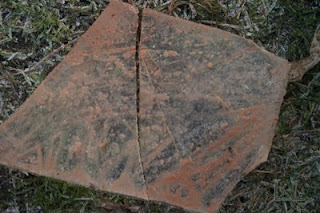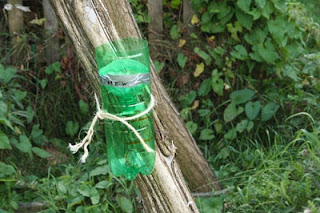I've been incredibly inspired lately by questions the children are asking at Dunkirk School. They ask questions all the time; and at the moment we are gathering ideas with them as we plan - with the children - what they would like to explore next term. Water, in various forms, keeps cropping up. The freezing weather has prompted some wonderful questions - they notice all the changes around them and are so eager for hands-on exploration. Above is the pond we've made on the school allotment - and below is what it looks like at the moment, all frozen:

This prompted wonderful questions and discussions - about ice but also about the creatures living in the pond and how they felt. The children were really interested in the ball left on the water as a means of air getting into the pond. It also led to some really important health and safety discussions about ice and venturing onto frozen water (or not). Children need the first hand experiences to prompt questioning and thinking - and the discussions that arise are crucial in their learning.
They were really interested in the frost on the leaves and the different colours, patterns and shapes this brought out. They were really amazed by leaves "glued" together by ice! They also drew into the ice and frost everywhere they could find to do so...
We found this piece of ice (below) last year and built a sculpture with it; and they've been recalling this and wondering if they'll be able to find similar pieces this year.
Many of the children adore making potions - they constantly experiment with different concoctions. We have a set of potion / mud-pie making equipment on the allotment all the time and the children return to it over and over...
So, the younger children were delighted to find a set of frozen mud cup cakes recently! The older children had made them and left them to "cook", but when the younger children found them the next day, they were frozen solid - and popped out of the bun cases in a perfect ice circle!
So,
they became the ingredient of a new ice-mud-water concoction made by a very
focused group…
If
ice breaks you notice further things about it…
and if you jangle frozen ice in your
hands, it makes amazing sounds…
But, does all ice sound the same the children wondered?
Water frozen in a bowl with leaves was deeply fascinating when they got the moulded ice
out! And, indeed, getting ice out of
any and all containers became a huge focus...
Ice
on hands with and without gloves prompted really good questions – they noticed
how ice began to melt when you held it and were so interested in how ice kept changing…
One of my favourite questions was asked by a year two
boy as we got ready to go out exploring.
I was handing out equipment for the children to help carry to the allotment
and this prompted one of the children to ask “why does the hot chocolate stay
hot?” as he was carrying one of the metal flasks. We’re planning lots of experiments with insulation and different
materials to test this out later… The
best questions always come from the children; but it needs adults who can listen
and help nurture the right kind of environment for questions to thrive…



















































